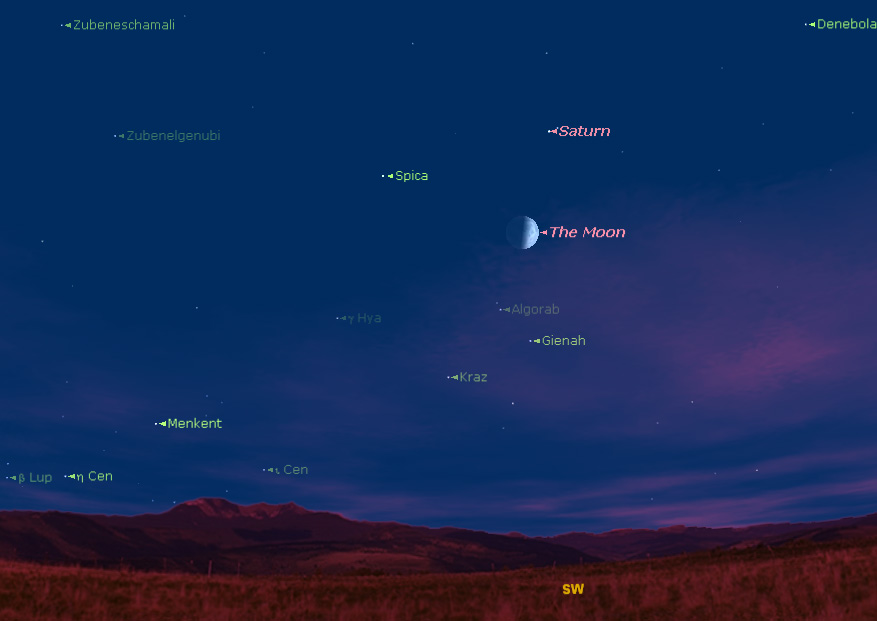
As darkness falls this evening (July 7), make sure to check out the south-southwest sky.
About one-third of the way up from the horizon to the point directly overhead you will see yet another in the monthly series of triangular configurations formed by the moon, a bright star and a bright planet.
The planet is Saturn with its remarkable rings. For those with access to even a small telescope, the sight is enlarged into one of the finest showpieces in the night sky. This sky map of the moon, Saturn and Spica shows how they will appear together tonight.
Saturn's famous ring system narrowed to a tilt of 7.3-degrees on June 12, but has since started to slowly open again. In addition, the planet was at east quadrature on July 3, meaning that from our viewpoint here on the Earth, it appeared to make a right angle with the sun. At this moment in time, the shadows cast to one side by the rings and globe of the planet will impart an almost three-dimensional appearance to Saturn. [Skywatching Events for July 2011]
In his book, "Pleasures of the Telescope," the late astronomer Garrett P. Serviss wrote:
“When Saturn is in view the owner of a telescope may become a recruiting officer for astronomy by simply inviting his friends to gaze at the wonderful planet. The silvery color of the ball, delicately chased with half-visible shadings, merging one into another . . . the grand arch of the rings, sweeping across the planet with a perceptible edging of shadow . . . these are some of the elements of a picture that can never fade from the memory of anyone who has once beheld it in its full glory.”
The rings can be glimpsed with a telescope magnifying at least 30-power. If you own a telescope with an aperture of 4 inches, you can get a very fine view at 100-power; with an 8-inch telescope, try 200-power, while with a 12-inch telescope, 300-power will be more than sufficient.
Get the Space.com Newsletter
Breaking space news, the latest updates on rocket launches, skywatching events and more!
Saturn's rings are not continuous sheets, but are composed of countless billions of tiny particles, each one circling like a moon around Saturn and reflecting sunlight. Many of these particles are ice crystals and those individual glints of reflected sunshine appear to run together at the great distance of the ringed planet now currently 899 million miles (1.45 billion km) from Earth.
You can use the moon to make a positive identification of the ringed wonder, as Saturn’s steady golden glow shines 8-degrees above and to the right of the half slice of the moon (your clenched fist, held at arm’s length measures approximately 10 degrees). Not too far — less than a degree — to Saturn’s right is the white third-magnitude star, Porrima, one of the best-known binary stars in the sky. [Read: Saturn Dances With a Double Star in June Night Sky]
Finally, there is the bluish-white star, Spica, which will sit a dozen degrees to the moon’s upper left. Spica and Saturn appear practically the same in brightness, being separated by just 0.1 magnitude in brightness, with Saturn appearing just a trifle brighter.
The triangle shape will remain in view until the moon sets just before midnight, local daylight time. Saturn and Spica will disappear into the horizon haze about a half hour later.
The next broad moon-Saturn-Spica triangle in the series will be formed on Aug. 3.
Joe Rao serves as an instructor and guest lecturer at New York's Hayden Planetarium. He writes about astronomy for The New York Times and other publications, and he is also an on-camera meteorologist for News 12 Westchester, N.Y.
Join our Space Forums to keep talking space on the latest missions, night sky and more! And if you have a news tip, correction or comment, let us know at: community@space.com.

Joe Rao is Space.com's skywatching columnist, as well as a veteran meteorologist and eclipse chaser who also serves as an instructor and guest lecturer at New York's Hayden Planetarium. He writes about astronomy for Natural History magazine, Sky & Telescope and other publications. Joe is an 8-time Emmy-nominated meteorologist who served the Putnam Valley region of New York for over 21 years. You can find him on Twitter and YouTube tracking lunar and solar eclipses, meteor showers and more. To find out Joe's latest project, visit him on Twitter.









